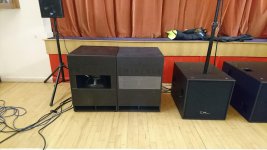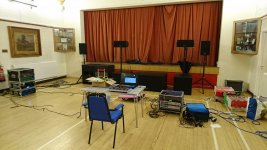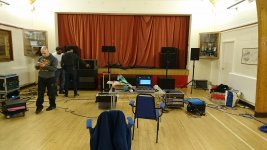Hi guys, in a few weeks my brother and I have hired a hall purely for system testing (near swindon UK if anyone else wants in on the idea). He has ohm 2x 118 subs, and ohm infrasub all running off xe 6000. I'll take both of my ppsls down with my rcf tops. I'll get a good idea then, having used many other types of sub I couldn't make a genuine comment on sound difference, purely because every event is a hectic affair. This time we don't have customers to worry about.
Hi guys,
I run the JBL 5322 64s and they use two 12s in slot loads with a 7:1 compression plate. IT's not PPSL, its push, push compression load. In this configuration they go lower because of air mass loading at the expense of 3-4 DB sense. Not quite apples to apples but I posted this to show that high compression ratios are used in the industry with good but slightly different results.
I run the JBL 5322 64s and they use two 12s in slot loads with a 7:1 compression plate. IT's not PPSL, its push, push compression load. In this configuration they go lower because of air mass loading at the expense of 3-4 DB sense. Not quite apples to apples but I posted this to show that high compression ratios are used in the industry with good but slightly different results.
Hi guys, in a few weeks my brother and I have hired a hall purely for system testing (near swindon UK if anyone else wants in on the idea). He has ohm 2x 118 subs, and ohm infrasub all running off xe 6000. I'll take both of my ppsls down with my rcf tops. I'll get a good idea then, having used many other types of sub I couldn't make a genuine comment on sound difference, purely because every event is a hectic affair. This time we don't have customers to worry about.
This sounds interesting - is it just you and your brother?
I'd like to take mine to something like this but each box needs two sturdy men to carry it, I'd have to hire a Transit van, and the amp is something like six stone... lol
Ok so my brother, a friend and I got together for a sound check. It proved to be a very revealing exercise to compare different subs.
We had 4 types of sub:
PPSL twin 15 kappa LF2 powered by macrotech 2401 with Cleo LSM
Ohm IS2400 infra sub (Push pull 6th order IIRC) powered with PKN XE6000 XTA LSM
Ohm 2x TRS 118 direct red BR 18in power by MC2 T2000 XTA LSM
Ohm MR450 x2 18" 6th order BP power by another MC2 T2000 XTA LSM
First thing to say is none of the subs came close to performance of the IS2400, it's frequency response is unbelievable, delivery#ing such low freq that eventually we turned right down because started to feel unwell.
The comparison of the 118s and the PPSLs was interesting. The PPSL seem very peaky in their freq response creating significant lift of freq at 60hz and around 120Hz. The 118's has a better frequency response and seemed to integrate well with the mid highs. But, that was the only good thing for the 118's. The 118s had a muddy almost distorted sound even at modest volumes that wasn't a patch on the PPSLs clarity. The PPSL proved to be far more sensitive the then the TRS cabs, and when turned up they were flat out head pounding creating chest thumping kick. Considering the cost, the PPSL is superior to the TRS118, I have no doubt the better loading of the TRS218 would even the field. I ran the MA2400 in parallel mono at 2ohms at full gain set on the amp, I didn't get the IOC to dim.
The MR450 gave a really nice sound clearer than the 118 but only at a fraction of the PPSL spl, they are great for their size but out classed by the larger PPSL.
We also compared mid highs we had, RCF C3110 10", Ohm Lunaray, and Ohm TRS212 mk1s. Here the winner was clear, the TRS212 is a class act even in this old guise, the comp drivers delivering Hi Fi clarity on chimes and cymbals. THe lunaray have an incredible output for their size but are very high end in their freq response. The RCF proved a good all rounder, and I think I could move their XO point lower.
With everything running we went outside where it was clear the poor hall was taking a beating, especially the doors!
We had 4 types of sub:
PPSL twin 15 kappa LF2 powered by macrotech 2401 with Cleo LSM
Ohm IS2400 infra sub (Push pull 6th order IIRC) powered with PKN XE6000 XTA LSM
Ohm 2x TRS 118 direct red BR 18in power by MC2 T2000 XTA LSM
Ohm MR450 x2 18" 6th order BP power by another MC2 T2000 XTA LSM
First thing to say is none of the subs came close to performance of the IS2400, it's frequency response is unbelievable, delivery#ing such low freq that eventually we turned right down because started to feel unwell.
The comparison of the 118s and the PPSLs was interesting. The PPSL seem very peaky in their freq response creating significant lift of freq at 60hz and around 120Hz. The 118's has a better frequency response and seemed to integrate well with the mid highs. But, that was the only good thing for the 118's. The 118s had a muddy almost distorted sound even at modest volumes that wasn't a patch on the PPSLs clarity. The PPSL proved to be far more sensitive the then the TRS cabs, and when turned up they were flat out head pounding creating chest thumping kick. Considering the cost, the PPSL is superior to the TRS118, I have no doubt the better loading of the TRS218 would even the field. I ran the MA2400 in parallel mono at 2ohms at full gain set on the amp, I didn't get the IOC to dim.
The MR450 gave a really nice sound clearer than the 118 but only at a fraction of the PPSL spl, they are great for their size but out classed by the larger PPSL.
We also compared mid highs we had, RCF C3110 10", Ohm Lunaray, and Ohm TRS212 mk1s. Here the winner was clear, the TRS212 is a class act even in this old guise, the comp drivers delivering Hi Fi clarity on chimes and cymbals. THe lunaray have an incredible output for their size but are very high end in their freq response. The RCF proved a good all rounder, and I think I could move their XO point lower.
With everything running we went outside where it was clear the poor hall was taking a beating, especially the doors!
Attachments
" The PPSL seem very peaky in their freq response creating significant lift of freq at 60hz and around 120Hz. "
Curious, mine have always measured ±3dB up to about 160hz.
Curious, mine have always measured ±3dB up to about 160hz.
Sedicirich,The comparison of the 118s and the PPSLs was interesting. The PPSL seem very peaky in their freq response creating significant lift of freq at 60hz and around 120Hz. The 118's has a better frequency response and seemed to integrate well with the mid highs.
The location of the two cabinets in the room was different, exciting different modal response.
The mid high cabinets were located directly above the 118 cabinets, so they would generally seem to integrate better than cabinets placed to the side.
It is difficult to conduct fair tests indoors, but if you have a symmetrical room, you can simply set the "A" speakers "Left" and the "B" speakers "Right", then individually set the appropriate low cut filter, then time/phase align each system, then individually EQ the L and R system to the desired target EQ, then pan a mono signal L/R.
After determining the "winner" of the A/B test, substitute the looser with "C", EQ it to the target EQ, and proceed again.
There are many different metrics to compare, you need to eliminate as many as possible so you can concentrate on important aspects of sound such as frequency extension, SPL and distortion "signature" at varying SPL levels.
Cheers,
Art
Many thanks Art.
We ran the 2 set ups A/B via cloud zoner, one zone was the PPSLs and the RCFs, the other zone the 118s and Lunarays. I also tested the 118s via my crown with the RCFs instead of the PPSLs, back and forth with the 2 subs. I didnt have the software for the cleo on the laptop I bought. But, I got an understanding of how the different designs were working. I would have liked to had some more advanced tools, the XTA RT2 didn't really tell us anything we couldn't hear with our own ears.
I would like to play with time alignment, but I'm not sure where to start.
However, I am very please with DJKs design, it certainly delivers the goods especially considering my competition will be running any level of boxes from skytec junk to half decent systems.
We ran the 2 set ups A/B via cloud zoner, one zone was the PPSLs and the RCFs, the other zone the 118s and Lunarays. I also tested the 118s via my crown with the RCFs instead of the PPSLs, back and forth with the 2 subs. I didnt have the software for the cleo on the laptop I bought. But, I got an understanding of how the different designs were working. I would have liked to had some more advanced tools, the XTA RT2 didn't really tell us anything we couldn't hear with our own ears.
I would like to play with time alignment, but I'm not sure where to start.
However, I am very please with DJKs design, it certainly delivers the goods especially considering my competition will be running any level of boxes from skytec junk to half decent systems.
You're welcome, Sedicirich.Many thanks Art.
I would like to play with time alignment, but I'm not sure where to start.
You could start by searching the dozens of posts that I have described how to do it, or buy audio books that describe the process.
Several concepts need to be understood to reliably "dial in" a proper time/phase response:
The speed of sound.
The difference between phase and polarity.
The phase contribution of crossover and loudspeaker components.
The phase contribution of different enclosure types.
Art
- Status
- Not open for further replies.
- Home
- Loudspeakers
- Subwoofers
- DJK PPSL build


